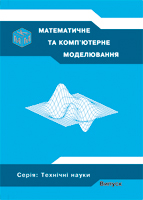Інтелектуальний об'єктно-орієнтований підхід до моделювання динамічних енергетичних систем
DOI:
https://doi.org/10.32626/2308-5916.2020-21.43-51Анотація
Запропонований об'єктно-орієнтований підхід та загальна архітектура інтелектуального програмного забезпечення для математичного моделювання динамічних енергетичних систем. Представлено та детально розглянуто архітектуру баз знань для моделювання систем, що описуються лінійними інтегральними рівняннями. Розглянутий система, заснована на знаннях у вигляді композиції конкретної функціональної мережі та експертної системиПосилання
Do & Nguyen Hien & Mai. A Method of Ontology Integration for Designing Intelligent Problem Solvers. Applied Sciences. 2019. DOI: 9.3793.10.3390/app9183793.
Wazwaz A. Linear and Nonlinear Integral Equations: Methods and Applications. 2011. DOI: 10.1007/978-3-642-21449-3.
Verlan A., Sterten Jo. Implementation of Integral Explicit Macromodels by means of Quick-Acting Algorithms. Mathematical and computer modelling. Series: Technical sciences. 2018. Vol. 18. P. 26-33. DOI: 10.32626/2308-5916.
Burton T. A. Volterra integral and Differential Equations. 2nd ed. Mathematics in science and Engineering, 202. Elsevier, 2005.
Jerri A.J. Introduction to Integral Equations with Applications. Seconded. Jhon Wiley and Sons, 1999.
Nadir M. Solving linear integral equations with Fibonacci polynomial. Malaya Journal of Matematik. 2018. Vol. 6. P. 711-715. DOI 10.26637/MJM0604/0001.
Adawi A. Fadi A., Husein J. A Numerical Method for Solving Linear Integral Equations. International Journal of Contemporar Mathematical Sciences. 2009. Vol. 4. P. 485-496.
Kameda T. A general method for solving linear integral equations. II. Proceedings of the Physico-Mathematical Society of Japan. 2020.
Mirceski V. Modification of the step-function method for solving linear integral equations and application in modelling of a voltammetric experiment. Journal of Electroanalytical Chemistry — J ELECTROANAL CHEM. 2003. Vol. 545. P. 29-37. DOI 10.1016/S0022-0728(03)00086-X.
Verlan A., Sizikov V. Integral equations: methods, algorithms, programs. Kiev : Naukova dumka, 1986.
Brosy N. Fredholm integral equation. 2020. DOI: 10.1002/9783527809080.cataz07129.
Abdul-Majid W. Fredholm Integral Equations. 2011. DOI: 10.1007/978-3-642-21449-3_15.
Georgiev S. Generalized Fredholm Integral Equations. 2016. DOI: 10.2991/978-94-6239-228-1_5.
Altürk A. On multidimensional Fredholm integral equations of the first kind. Journal of Inequalities and Special Functions. 2017. Vol. 8. P. 85-95.
Machado M., Margotti F., Leitao A. On Nonstationary Iterated Tikhonov Meth-ods for Ill-Posed Equations in Banach Spaces. 2018. DOI: 10.1007/978-3-319-70824-9_10.
Argyros I.K., Santhosh G., Shobha E. Discretized Newton-Tikhonov method for ill-posed hammerstein type equations. Communications on Applied Nonlinear Analysis. 2016. Vol. 23. P. 34-55
Favini A., Pandolfi L. Multiscale Lavrentiev method for systems of Volterra equations of the first kind. Journal of Inverse and Ill-posed Problems — J INVERSE ILL-POSED PROBL. 2008. Vol. 16. P. 221-238.
Wang L. Karhunen-Loeve expansions and their applications. 2008.
Hartley R. An Overview of Conceptual Programming I. 2020
##submission.downloads##
Опубліковано
Номер
Розділ
Ліцензія
Authors who publish with this journal agree to the following terms:- Authors retain copyright and grant the journal right of first publication with the work simultaneously licensed under a Creative Commons Attribution License that allows others to share the work with an acknowledgement of the work's authorship and initial publication in this journal.
- Authors are able to enter into separate, additional contractual arrangements for the non-exclusive distribution of the journal's published version of the work (e.g., post it to an institutional repository or publish it in a book), with an acknowledgement of its initial publication in this journal.
- Authors are permitted and encouraged to post their work online (e.g., in institutional repositories or on their website) prior to and during the submission process, as it can lead to productive exchanges, as well as earlier and greater citation of published work (See The Effect of Open Access).

